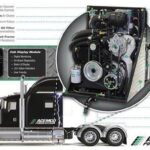The Dd16 Turbo Compound engine, found in Freightliner and Western Star trucks, utilizes innovative technology to enhance performance and fuel economy. This article delves into the mechanics of turbo compounding, its benefits, and its adoption across the trucking industry. We’ll explore how the DD16 turbo compound compares to other fuel efficiency solutions and its potential impact on the future of trucking.
Volvo D13 engine showcasing turbo compounding technology (TruckTube via YouTube)
Turbo compounding recovers waste heat energy from the exhaust stream and converts it into usable power, boosting engine output and reducing fuel consumption. Detroit, part of Daimler Trucks North America, employs this technology in its DD16 engine, its largest powerplant. The DD16 turbo compound generates up to approximately 192 pound-feet of torque, significantly improving pulling power and overall performance.
A Detroit DD15 engine, notably without turbo compounding, displayed at a 2016 truck show. (John Sommers II for Transport Topics)
While Detroit utilizes turbo compounding in the DD16, it has opted for a different approach with its DD15 engine. Instead of turbo compounding, the DD15 leverages a proprietary Asymmetric Turbocharger. This design prioritizes simplification, efficiency, and durability while reducing weight. It achieves fuel efficiency through features like a variable-speed water pump and optimized piston design. This highlights the diverse approaches to improving engine performance within the industry.
Volvo Trucks, another major player, incorporates turbo compounding in its D13TC engine. Volvo claims this technology increases fuel efficiency by 7.5% and adds 50 horsepower. They achieve this by utilizing waste heat that would normally be lost through the exhaust or cooling system. This recovered energy is then fed back into the engine, effectively increasing its overall efficiency.
John Moore, Volvo Trucks’ product marketing manager for powertrain, discusses turbo compounding technology. (Source: Article Image)
However, not all manufacturers embrace turbo compounding. Navistar, for instance, focuses on refining existing turbocharger technology and implementing other efficiency improvements. They argue that added complexity from turbo compounding can increase maintenance costs and potential downtime, negating fuel economy gains. This difference in approach underscores the ongoing debate within the trucking industry regarding the optimal path to fuel efficiency.
The Mack MP8HE engine utilizes Mack Energy Recovery Technology, a form of turbo compounding. (Mack)
Mack Trucks, also part of the Volvo Group, offers turbo compounding in its MP8HE engine, demonstrating the technology’s varied applications across different engine platforms. Mack claims its Energy Recovery Technology, combined with aerodynamic enhancements, delivers up to a 9.5% fuel efficiency improvement. This illustrates the potential of turbo compounding to contribute significantly to fuel savings.
The future of turbo compounding and its role in the trucking industry remain uncertain. While some manufacturers champion its benefits, others pursue alternative solutions. The ongoing evolution of engine technologies, coupled with stricter environmental regulations and market demands, will ultimately determine the prevalence of turbo compounding in the years to come. The DD16 turbo compound stands as a prime example of this technology’s potential to deliver substantial performance and efficiency gains in heavy-duty trucking applications.

